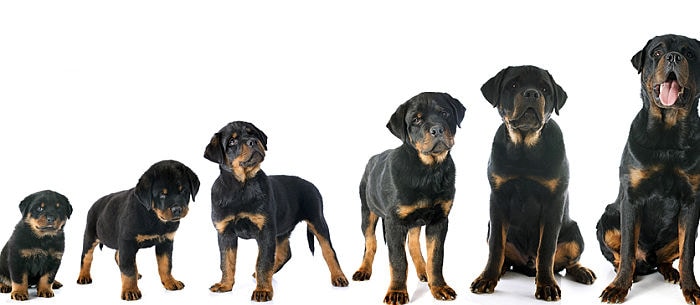Dogs come in many breeds in a wide range of different groups. According to the American Kennel Club, those groups are toy, herding, hound, sporting, terrier, working and non-sporting. Looking at a breed’s puppy growth chart can help you determine the right size dog for your family.
For your dog’s specific projected growth, this puppy growth chart site will make calculations based on your dog’s current weight, age and breed.
There is some information about popular breeds below:

- Bull Terrier
Weight for the bull terrier ranges from 35 to 75 pounds.
- Golden Retriever
This popular large breed averages 70 pounds.
- Weimaraner
Although some Weimaraners can grow to 100 pounds, the average is 75 to 80 pounds.
- Maltese
The tiny Maltese will get just a few inches more than a foot tall and weigh between five and 15 pounds.
- Scottish Terrier
This breed averages 19 to 23 pounds.
- American Pit Bull Terrier
A desirable weight for this breed is between 30 and 60 pounds.
- Greyhound
These racing dogs tend to be about two feet tall and 50 to 85 pounds.
- Irish Wolfhound
On average, the affectionate Irish wolfhound is between 115 and 180 pounds.
- Fox Terrier
This small breed measures just over a foot tall at the shoulder and weighs just under 20 pounds on average.
- English Setter
This energetic dog can grow to a little more than two feet tall and weigh about 60 pounds on average.
- Pekingese
This furry little companion will only weigh about 14 pounds.
- Dalmatian
This iconic breed can weigh anywhere from 35 to 70 pounds.
- Saint Bernard
These gentle giants typically weigh between 120 and 180 pounds.
- Bloodhound
Known for their wrinkles and sense of smell, the bloodhound typically weighs between 70 and 110 pounds.
- Anatolian Shepard Dog
This is a hefty breed, averaging between 80 and 150 pounds.
- Basset Hound
These sad-eyed cuties grow to weigh about 60 pounds.
- Border Collie
Don’t let the fluff fool you. This medium breed usually doesn’t weigh over 50 pounds.
- Pug
This breed can have a lot of weight issues but shouldn’t weigh over 20 pounds.
- Cocker Spaniel
This breed typically weighs between 25 and 35 pounds.
- Basenji
The basenji typically weighs in around 26 pounds.
- Mastiff
This massive breed can exceed 200 pounds.
- Chihuahuas
This little guy averages around seven pounds and usually finishes growing by his first birthday.
- Cairn Terrier
The “Toto” breed typically weighs in around 15 pounds.
- Belgian Malinois
They tend to be about 60 pounds once they’re grown.
- Shetland Sheepdog
This herding dog’s weight can vary quite a bit.
- Pomeranian
Under all that fur, a Pomeranian only weighs about seven pounds.
- Shih Tzu
Their mature weight ranges from nine to 16 pounds.
- Miniature Schnauzers
These little cuties will weigh between 12 and 20 pounds.
- Great Dane
This gentle giant tends to weigh in at about 130 pounds.
- Siberian Husky
These fluffy friends tend to weigh about 60 pounds.
- Pointers
The average weight is about 60 pounds.
- Dachshunds
Dachshunds typically won’t get heavier than 40 pounds.
- Rottweiler
This large breed typically grows to be between 110 and 130 pounds.
- Boxers
Mature boxers usually weigh in between 65 and 75 pounds.
- Poodles
Weight from one end of the spectrum to the other — teacup to standard — varies greatly.
- Yorkshire Terriers
Yorkies can have an adult weight in the range of three to seven pounds.
- Beagle
They generally weigh between 22 and 25 pounds.
- Bulldog
These wrinkled canines may be short, but they usually weigh around 50 pounds.
- German Shepard
They average out at about 70 pounds.
- Labrador Retriever
These popular dogs often grow to 50 pounds at only seven months of age.
A puppy growth chart can serve as a guide. However, you should also consider other specific factors such as the weight of the puppy’s parents and that males typically weigh more than the females. Knowing the size you should expect for your puppy can also help identify potential health issues, an inappropriate diet or abnormal growth.
Thinking of bringing a new pupy into your home? Read Your New Puppy Checklist to make sure you’re prepared, and have a pet sitter on speed dial for those times you have to stay late at work.
Jennifer Stauffer worked on Capitol Hill in PR and legislation before becoming a mother in 2011. She now blogs about parenting and pop culture at Mom Tattles and is hopeful to publish her first novel soon.



